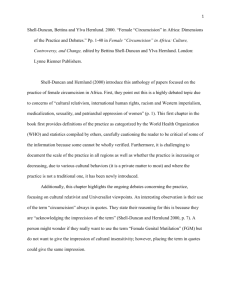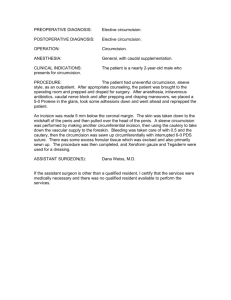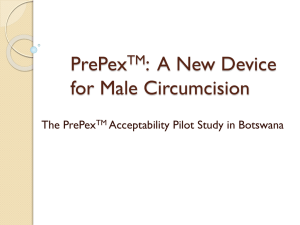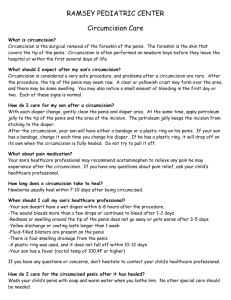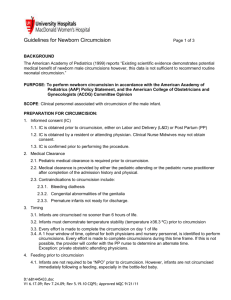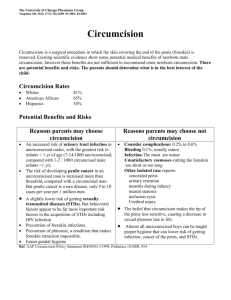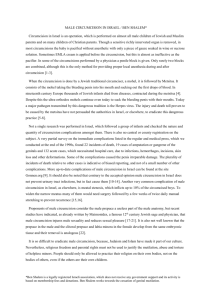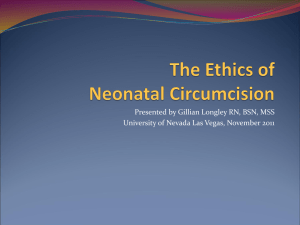Female circumcision
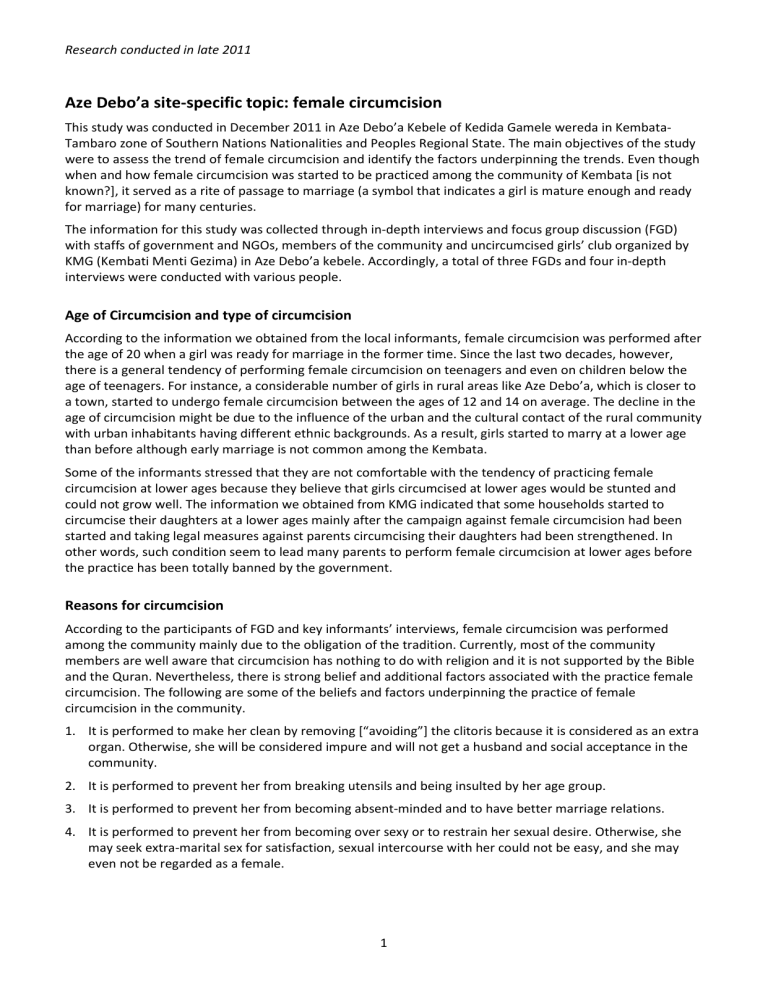
Research conducted in late 2011
Aze Debo’a site-specific topic: female circumcision
This study was conducted in December 2011 in Aze Debo’a Kebele of Kedida Gamele wereda in Kembata-
Tambaro zone of Southern Nations Nationalities and Peoples Regional State. The main objectives of the study were to assess the trend of female circumcision and identify the factors underpinning the trends. Even though when and how female circumcision was started to be practiced among the community of Kembata [is not known?], it served as a rite of passage to marriage (a symbol that indicates a girl is mature enough and ready for marriage) for many centuries.
The information for this study was collected through in-depth interviews and focus group discussion (FGD) with staffs of government and NGOs, members of the community and uncircumcised girls’ club organized by
KMG (Kembati Menti Gezima) in Aze Debo’a kebele. Accordingly, a total of three FGDs and four in-depth interviews were conducted with various people.
Age of Circumcision and type of circumcision
According to the information we obtained from the local informants, female circumcision was performed after the age of 20 when a girl was ready for marriage in the former time. Since the last two decades, however, there is a general tendency of performing female circumcision on teenagers and even on children below the age of teenagers. For instance, a considerable number of girls in rural areas like Aze Debo’a, which is closer to a town, started to undergo female circumcision between the ages of 12 and 14 on average. The decline in the age of circumcision might be due to the influence of the urban and the cultural contact of the rural community with urban inhabitants having different ethnic backgrounds. As a result, girls started to marry at a lower age than before although early marriage is not common among the Kembata.
Some of the informants stressed that they are not comfortable with the tendency of practicing female circumcision at lower ages because they believe that girls circumcised at lower ages would be stunted and could not grow well. The information we obtained from KMG indicated that some households started to circumcise their daughters at a lower ages mainly after the campaign against female circumcision had been started and taking legal measures against parents circumcising their daughters had been strengthened. In other words, such condition seem to lead many parents to perform female circumcision at lower ages before the practice has been totally banned by the government.
Reasons for circumcision
According to the participants of FGD and key informants’ interviews, female circumcision was performed among the community mainly due to the obligation of the tradition. Currently, most of the community members are well aware that circumcision has nothing to do with religion and it is not supported by the Bible and the Quran. Nevertheless, there is strong belief and additional factors associated with the practice female circumcision. The following are some of the beliefs and factors underpinning the practice of female circumcision in the community.
1.
It is performed to make her clean by removing [“avoiding”] the clitoris because it is considered as an extra organ. Otherwise, she will be considered impure and will not get a husband and social acceptance in the community.
2.
It is performed to prevent her from breaking utensils and being insulted by her age group.
3.
It is performed to prevent her from becoming absent-minded and to have better marriage relations.
4.
It is performed to prevent her from becoming over sexy or to restrain her sexual desire. Otherwise, she may seek extra-marital sex for satisfaction, sexual intercourse with her could not be easy, and she may even not be regarded as a female.
1
Research conducted in late 2011
5.
It is performed because it is a rite of passage to marriage, to respect a tradition of their community passing down from generation to generation and one is born and socialized.
6.
It is performed to be respected by the community or for the respect of their own family. On top of that, it is believed that an uncircumcised girl will become disobedient, uncontrollable, insubordinate, powerful, untamed, uncouth, and ill-mannered if she is not circumcised. Furthermore, there are numerous local terms used to insult and degrade the uncircumcised girl among the Kembata such as referring her to be an untrained mare and having a prickle, a comb or with three legs.
The Existing Trend and the Resulting Impact
Currently, most of the participants of in-depth interviews and focus group discussions are aware of the harmful effect of female circumcision as result of various activities that have been undertaken in the area mainly since the last two decades such as continuous education, sensitization workshops, information dissemination through the mass media, distribution of written materials, house to house visits and one to one communication. In this regard, there are a large number of international and local NGOs directly working against female circumcision, and that have incorporated the issue of female circumcision into their health component such as KMG, World Vision, the Ethiopian Kalehiwot Church, the Evangelical Church Mekaneyesus and others. As the informants further argue, there is no ritual or ceremony celebrated to mark the occasion and no invitation of friends, relatives and neighbours in the study area as it had been before. Moreover, KMG organized a large number of uncircumcised girls’ clubs comprising girls between the ages of 12 and 15 in every kebele of the zone without including other uncircumcised girls under training and close follow ups by other
NGOs.
As a result, some uncircumcised girls were able to perform their marriage during the last few years without including those who got married some years ago as a result of the education provided by the Sudan Interior
Mission (SIM). In this connection, one of our informants stated that dozens of uncircumcised girls got married and had become mothers of children as a result of preaching against female circumcision by the evangelists and missionaries of SIM some 40 years ago. He further argued that female circumcision was on the verge of disappearing from the land of Kembata. Unfortunately, the effort was aborted due to the sudden evacuation of SIM missionaries from Kembata soil being enforced by the Derg regime. Subsequently, he underlined that they were not educated about the health hazards of female circumcision during those days, but they were simply condemning it as a sin and not supported by the Bible. Besides that the effort was not backed by local leaders and members of other Christian denominations such as Orthodox and Catholic or by government officials and functionaries. As a result, the uncircumcised girls and women were exposed to insult, mockery and discrimination by the community.
Currently, the uncircumcised girls and women in Kembata do not face such serious problems from the mass compared to the situation 40 years ago due to relatively better awareness among the community and the legal measures taken against offenders, parents circumcising their daughters and the practitioners of female circumcision. In comparison with the rural and urban areas, an insult is still a problem in some rural areas.
On the other hand, thousands of uncircumcised girls marched to the zone capital of Kembata and held a demonstration in 2010 carrying various slogans saying, “We do not want to be circumcised”, “performing female circumcision is a crime”, and others. Among these girls, some of them got married without being circumcised. The participants of FGDs added that the legal measures taken against those who perform female circumcision have started to be lenient especially after the 2005 national election because KMG was suspected to support the opposition party members. A new trend of taking girls to private clinics and pharmacies at late nights for circumcision by carrying them as patients seeking emergency assistance was started even though it was immediately contained by the cooperation of the community and effort of law enforcing bodies. Currently, however, the practice of female circumcision seems to be abandoned throughout the zone except a few border areas with Halaba and Hadiya communities due to strong support from the government bodies.
2
Research conducted in late 2011
3
